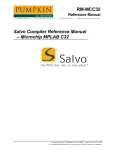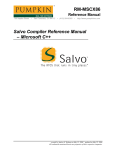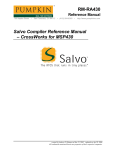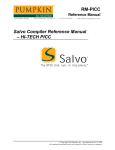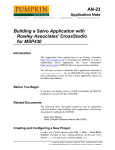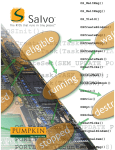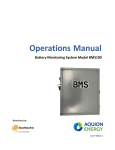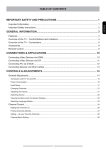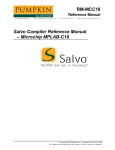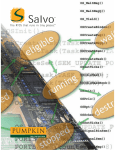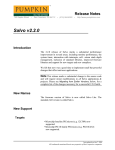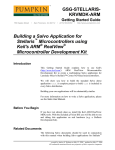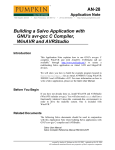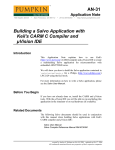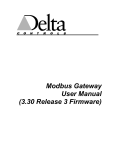Download AVR-GCC - Pumpkin, Inc.
Transcript
RM-GCCAVR
Reference Manual
750 Naples Street
•
San Francisco, CA 94112
• (415) 584-6360
•
http://www.pumpkininc.com
Salvo Compiler Reference Manual
– AVR-GCC
© Copyright 2003 Pumpkin, Inc. last updated on Jun 5, 2008
All trademarks mentioned herein are properties of their respective companies.
Reference Manual
Introduction
This manual is intended for Salvo users who are targeting Atmel
(http://www.atmel.com/)
AVR®
and
MegaAVR™
1
microcontrollers with GNU's AVR-GCC C/C++ compiler for
AVR.
Note It is assumed that the IDE used is Atmel's AVR Studio1,
commonly installed as part of the WinAVR2 tool suite.
Related Documents
The following Salvo documents should be used in conjunction
with this manual when building Salvo applications with the AVRGCC C/C++ compiler:
•
Salvo User Manual
Example Projects
Example Salvo projects for use with the AVR-GCC C/C++
compiler can be found in the:
\Pumpkin\Salvo\Example\AVR\
directories of every Salvo for Atmel AVR and MegaAVR
distribution.
Tip These example projects can be easily modified for any AVR
or MegaAVR device.
Features
Table 1 illustrates important features of Salvo's port to the AVRGCC C/C++ compiler.
1
2
2
Available directly from Atmel's website, http://www.atmel.com/.
"Windows for AVR", available at http://winavr.sourceforge.net/.
RM-GCCAVR Salvo Compiler Reference Manual – AVR-GCC
Reference Manual
General
Abbreviated as
GCCAVR
Salvo Lite, LE & Pro
for Atmel AVR and MegaAVR
entire AVR and MegaAVR family
salvoportgccavr.h
salvoportgccavr.S,
salvoportgccavr256.S
Available distributions
Supported targets
Header file(s)
Other target-specific file(s)
salvocfg.h
Compiler auto-detected?
Include target-specific header file
in salvocfg.h?
yes
2
yes
Libraries
Located in
Lib\GCCAVR
Context Switching
Method
Labels required?
Size of auto variables and function
parameters in tasks
function-based via
OSDispatch() & OSCtxSw()
no
total size must not exceed 254 8-bit
bytes
Memory & Registers
Internal and external RAM
supported?
yes / yes (see section on external
memory)
Interrupts
Interrupt latency in context
switcher
Interrupts in critical sections
controlled via
Default behavior in critical sections
2 cycles
user hooks
see example user hooks
Debugging
Source-level debugging with Pro
library builds?
yes
Compiler
Bitfield packing support?
printf() / %p support?
va_arg() support?
no
yes / yes
yes
Table 1: Features of Salvo port to GNU's AVR-GCC
C/C++ compiler
Libraries
Nomenclature
The Salvo libraries for the AVR-GCC C/C++ compiler follow the
naming convention shown in Figure 1.
RM-GCCAVR Salvo Compiler Reference Manual – AVR-GCC
3
Reference Manual
lib s fg c c a v r-a .a
S a lv o lib r a ry
c o n fig u r a tio n
a : m u ltita s k in g w ith d e la y s a n d e v e n ts
d : m u ltita s k in g w ith d e la y s
e : m u ltita s k in g w ith e v e n ts
m : m u ltita s k in g o n ly
t: m u ltita s k in g w ith d e la ys a n d e v e n ts ,
ta s k s c a n w a it w ith tim e o
ty p e
f: fre e w a re
l: s ta n d a rd
G C C -AV R
C C o m p ile r
ta rg e t
a v r:
AV R a n d M e g a AV R ,
1 2 8 K B a n d s m a lle r
p ro g ra m m e m o ry
a tm 2 5 6 : M e g a AV R w ith 2 5 6 K B
a n d la rg e r p ro g ra m
m e m o ry
o p tio n
-: n o o p tio n
i: lib ra ry in c lu d e s d e b u g g in g in fo rm a tio n
Figure 1: Salvo library nomenclature – GNU's AVR-GCC
C/C++ C compiler
Type
Salvo Lite distributions contain freeware libraries. All other Salvo
distributions contain standard libraries. See the Libraries chapter of
the Salvo User Manual for more information on library types.
Target
Each library is intended for one or more specific processors with
internal SRAM. Table 1 lists the correct library for each AVR and
MegaAVR processor.
Target Code
avr:
atm256:
Processor(s)
AVR and megaAVR devices with up
to 128KB of program memory
(e.g. AT90S8515, ATmega16,
ATmega128). These libraries all use
the basic AVR instruction set.
megaAVR devices with 256KB or
more of program memory
(e.g. ATmega2561). These libraries
use the extended AVR instruction
set.
Table 1: Processors for Salvo libraries GNU's AVR-GCC
C/C++ compiler
Option
Salvo Pro users can select between two sets of libraries – standard
libraries, and standard libraries incorporating source-level
debugging information.3 The latter have been built with the AVRGCC C/C++ compiler's -g command-line option. This adds
source-level debugging information to the libraries, making them
4
RM-GCCAVR Salvo Compiler Reference Manual – AVR-GCC
Reference Manual
ideal for source-level debugging and stepping in the AVRStudio
IDE. To use these libraries, simply select one that includes the
debugging information (e.g. libsalvolgccavrit.a) instead of
one without (e.g. libsalvolgccavr-t.a) in your project.
Configuration
Different library configurations are provided for different Salvo
distributions and to enable the user to minimize the Salvo kernel's
footprint. See the Libraries chapter of the Salvo User Manual for
more information on library configurations.
Build Settings
Salvo's libraries for the AVR-GCC C/C++ compiler are built using
the default settings outlined in the Libraries chapter of the Salvo
User Manual. Target-specific settings and overrides are listed in
Table 2.
Target-specific Settings
Delay sizes
Idling hook
Interrupt hook
Watchdog hook
System tick counter
Task priorities
8 bits
dummy,
can be overridden
disables then restores GIE bit,
can be overridden
clears WDT without other changes,
can be overridden
available, 32 bits
enabled
Table 2: Build settings and overrides for Salvo libraries
for GNU's AVR-GCC C/C++ compiler
Note Salvo Lite libraries have precompiled limits for the number
of supported tasks, events, etc. Salvo LE and Pro libraries have no
such limits. See the Libraries chapter of the Salvo User Manual for
more information.
Available Libraries
There are a total of 22 Salvo libraries for the AVR-GCC C/C++
compiler. Each Salvo for Atmel AVR and MegaAVR distribution
contains the Salvo libraries of the lesser distributions beneath it.
RM-GCCAVR Salvo Compiler Reference Manual – AVR-GCC
5
Reference Manual
Target-Specific Salvo Source Files
The source file salvoportgccavr.S is needed for Salvo Pro
source-code builds for targets with up to 128KB program memory
space.
The source file salvoportgccavr256.S is needed for Salvo Pro
source-code builds for targets with 256KB and greater program
memory space.
Note Never re-name portgccavrXXX.S to portgccavrXXX.s, as
the makefile treats these as two different files. The .S file is a user
ASM code, whereas the .s file is an intermediate file generated by
AVR-GCC that can be deleted.
salvocfg.h Examples
Below are examples of salvocfg.h project configuration files for
different Salvo for Atmel AVR and MegaAVR distributions.
Salvo Lite Library Build
#include <avr/io.h>
#define OSUSE_LIBRARY
#define OSLIBRARY_TYPE
#define OSLIBRARY_CONFIG
#define OSTASKS
#define OSEVENTS
#define OSEVENT_FLAGS
#define OSMESSAGE_QUEUES
TRUE
OSF
OST
2
4
0
1
Listing 1: Example salvocfg.h for library build using
libsalvofgccavr-t.a
Salvo LE & Pro Library Build
#include <avr/io.h>
#define OSUSE_LIBRARY
#define OSLIBRARY_TYPE
#define OSLIBRARY_CONFIG
#define OSTASKS
#define OSEVENTS
#define OSEVENT_FLAGS
#define OSMESSAGE_QUEUES
TRUE
OSL
OST
7
13
3
2
Listing 2: Example salvocfg.h for library build using
libsalvolgccavr-t.a
6
RM-GCCAVR Salvo Compiler Reference Manual – AVR-GCC
Reference Manual
Salvo Pro Source-Code Build
#include <avr/io.h>
#define OSENABLE_IDLING_HOOK
#define OSENABLE_SEMAPHORES
#define OSTASKS
#define OSEVENTS
#define OSEVENT_FLAGS
#define OSMESSAGE_QUEUES
TRUE
TRUE
9
17
2
4
Listing 3: Example salvocfg.h for source-code build
Performance
Memory Usage
tutorial memory usage4
total ROM5
total RAM6
2472
2448
3610
58
58
57
\AVR\AT90S8515\…\tut5lite
\AVR\AT90S8515\…\tut5le
\AVR\AT90S8515\…\tut5pro
Table 3: ROM and RAM requirements for Salvo
applications built with GNU's AVR-GCC C/C++ compiler
User Hooks
Overriding Default Hooks
In library builds, users can define new hook functions in their
projects and the linker will choose the user function(s) over the
default function(s) contained in the Salvo library.
In source-code builds, users can remove the default hook file(s)
from the project and substitute their own hook functions.
Idling
The default idling hook in salvohook_idle.c is a dummy
function, as shown below.
void OSIdlingHook ( void )
{
;
}
Listing 4: Default Salvo idling hook for GNU's AVR-GCC
C/C++ compiler
RM-GCCAVR Salvo Compiler Reference Manual – AVR-GCC
7
Reference Manual
Users can replace it (e.g. with a directive to put the AVR to sleep)
by building their own version with their application.
Interrupt
The default interrupt hooks in salvohook_interrupt.c are
shown below.7
static uint8_t sreg;
void OSDisableHook(void)
{
uint8_t sreg_local;
sreg_local = SREG;
cli();
sreg = sreg_local;
}
void OSEnableHook(void)
{
SREG = sreg;
}
Listing 5: Default Salvo interrupt hooks GNU's AVR-GCC
C/C++ compiler
These functions clear the GIE bit (i.e. disable global interrupts)
across Salvo's critical section, and restore the bit to its previous
value thereafter. These hooks are suitable for all applications.
These hooks work very well within Salvo services called from
interrupts, as the GIE bit is automatically cleared upon entry to an
interrupt. Therefore interrupts are not re-enabled at the end of a
Salvo service that is called in an ISR. This avoids unnecessary
interrupt nesting. The use of the auto variable sreg_local avoids
issues that would affect the shared global sreg when a Salvo
service is called from within an ISR.
Note Not disabling all source of interrupts that call Salvo services
during critical sections will cause the Salvo application to fail.
Watchdog
The default watchdog hook in salvohook_wdt.c is shown below.8
void OSClrWDTHook ( void )
{
8
RM-GCCAVR Salvo Compiler Reference Manual – AVR-GCC
Reference Manual
wdt_reset();
}
Listing 6: Default Salvo watchdog hook for GNU's AVRGCC C/C++ compiler
Users can replace it (e.g. with a dummy function – this would stop
Salvo from clearing the watchdog timer and allow the user to clear
it elsewhere) by building their own version with their application.
Compiler Issues
Incompatible Optimizations
All compiler optimizations (-O1, -O2 & -O3) are currently
incompatible with Salvo code and Salvo tasks. Users should build
their projects with optimizations off (-O0).
Other code (e.g. user functions, non-Salvo libraries, etc.) can be
used with compiler optimizations without issues.
A solution to allow compiler optimizations to be used with Salvo
code and Salvo tasks is currently under development.
Register R1
The avr-libc library which is an integral part of AVR-GCC
assumes register R1 will always have a 0 value, and Salvo does not
modify this register.
Special Considerations
ATmega2560/2561 (256KB and greater program memory)
GNU's AVR-GCC C/C++ compiler does not yet fully support
function pointers that span the 256KB or greater program memory
space. Salvo supports these parts by considering only the low-order
16 bits of each task function pointer (tFP). Therefore Salvo tasks
can only be located in the lower 128KB of program memory space.
When building a Salvo application for 256KB or greater program
memory space from Salvo libraries or Salvo source code, be sure
RM-GCCAVR Salvo Compiler Reference Manual – AVR-GCC
9
Reference Manual
to use the library or source code modules appropriate for the larger
program memory model.
Stack Issues
The AVR-GCC compiler uses the same stack for return addresses
and for local storage. The Y pointer (R29:R28) is used as a frame
pointer.
Compared to a non-Salvo, non-multitasking application with
similar call trees, the corresponding Salvo application will require
an additional 4 bytes (i.e. one return addresses) in the hardware
stack9.
External SRAM
Salvo's global objects10 can be placed in internal or external RAM.
The placement of data objects is controlled by linker options, and
takes the format -Wl,-Tdata=0x800000+start for relocationg
the program data section (ie: variable storage) where the
0x800000+start means hex address with an 0x800000 offset. There
is no end location, it is your responsibility as a programmer to not
use more RAM than you have. For example:
AVR-GCC … -Wl,-Tdata=0x800260 …
specifies that the data program area start at 0x260 (the end of
internal SRAM). This could be added to your makefile with the
rest of the linker flags (normally called LFLAGS), and in fact your
makefile may already be set up for working with external SRAM.
If you do this you also have to make sure the processor hardware is
set up to use external RAM. It is best to do this as early as
possible, in fact the absolute best way is to make a file called
xram.S, and fill it with something like this:
;; begin xram.S
#include <avr/io.h>
.section .init1,"ax",@progbits
ldi r16,(1<<SRE) | (1<<SRW)
out _SFR_IO_ADDR(MCUCR),r16
;; end xram.S
This would work for the AT90S8515, enabling the external XRAM
with one wait state. The file should be added to your project. Note
10
RM-GCCAVR Salvo Compiler Reference Manual – AVR-GCC
Reference Manual
that the code executed in that file takes place very early on, before
anything like the stack has been set up.
Data Segments
The RAMPD register is normally used to access the entire data space
on processors with more than 64K bytes data space. There are no
provisions for accessing Salvo's global objects outside of the
current data segment of 64K bytes.
Credits & Acknowledgements
Colin O'Flynn originally wrote the Salvo context switcher in
salvoportgccavr.S, created the Salvo project makefile system
for the Salvo v3 port to AVR-GCC, and wrote much of the
documentation surrounding the Salvo v3 port to GNU's AVR-GCC
compiler. Colin is active in the AVR community and is the author
of various AVR-centric material to be found at the popular AVR
Freaks (http://www.avrfreaks.net/) website.
1
2
3
4
5
6
7
8
9
10
tinyAVR devices are not supported because of their lack of RAM.
This is done automatically through the __GNUC__ and __AVR __ symbols
defined by the compiler.
The Salvo libraries provided with Salvo Lite and LE do not contain AVRGCC-debugger-compatible debugging information because this requires the
inclusion of source file listings.
Salvo 4.1.2 with WinAVR release 20071221rc1.
.text + .data + .bootloader sections, in bytes, with optimization setting
of -O0.
.data + .bss + .noinit sections, in bytes, with optimization setting of -O0.
This hook is valid for all AVR and MegaAVR targets because the register and
GIE bit locations are the same for all targets.
This hook is valid for all AVR and MegaAVR targets because the watchdog
control register is the same for all targets.
Salvo Pro application can reduce this by 2 bytes (one return address) by
inlining OSSched().
E.g. task control blocks, queue pointers, counters, etc.
RM-GCCAVR Salvo Compiler Reference Manual – AVR-GCC
11











